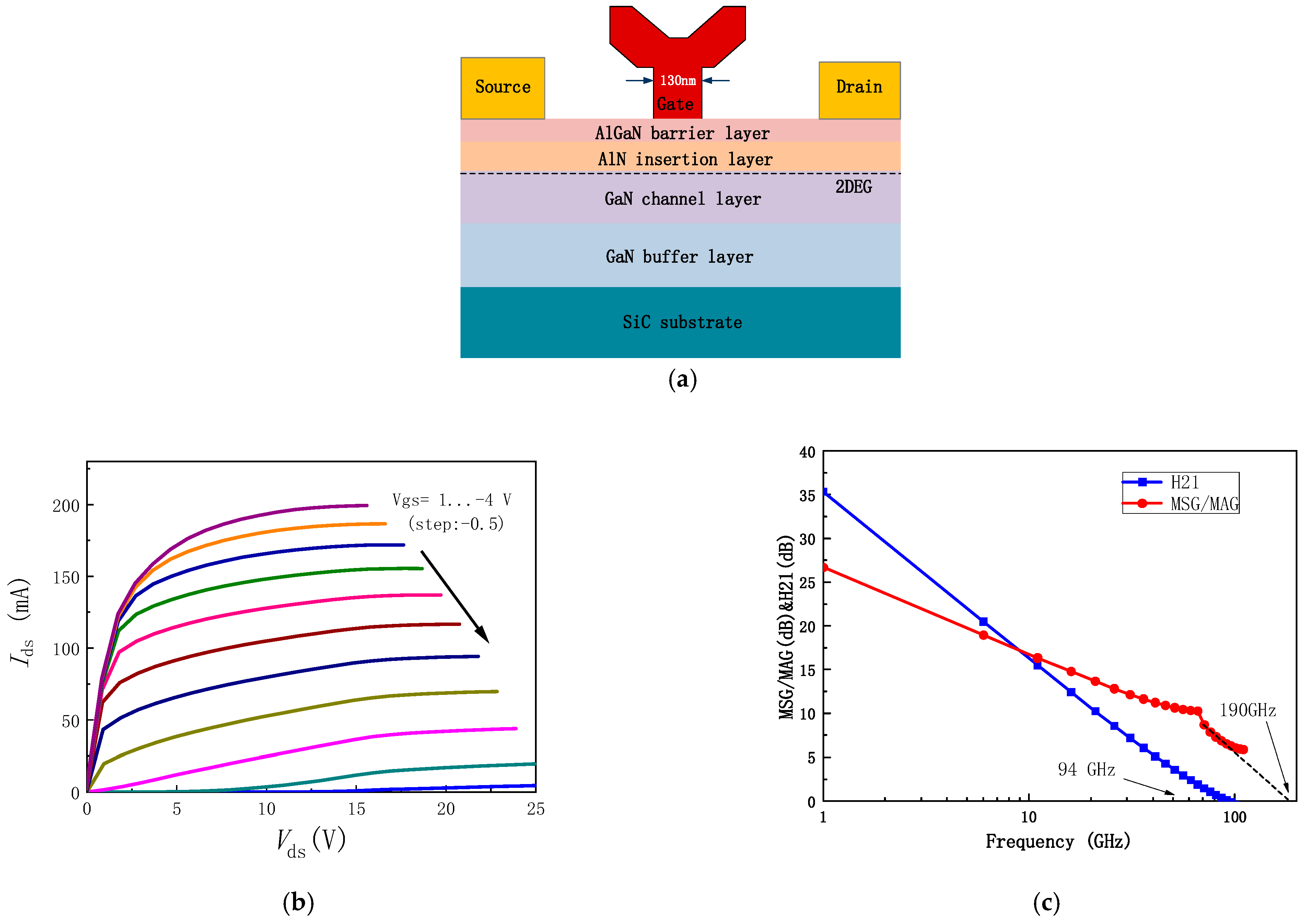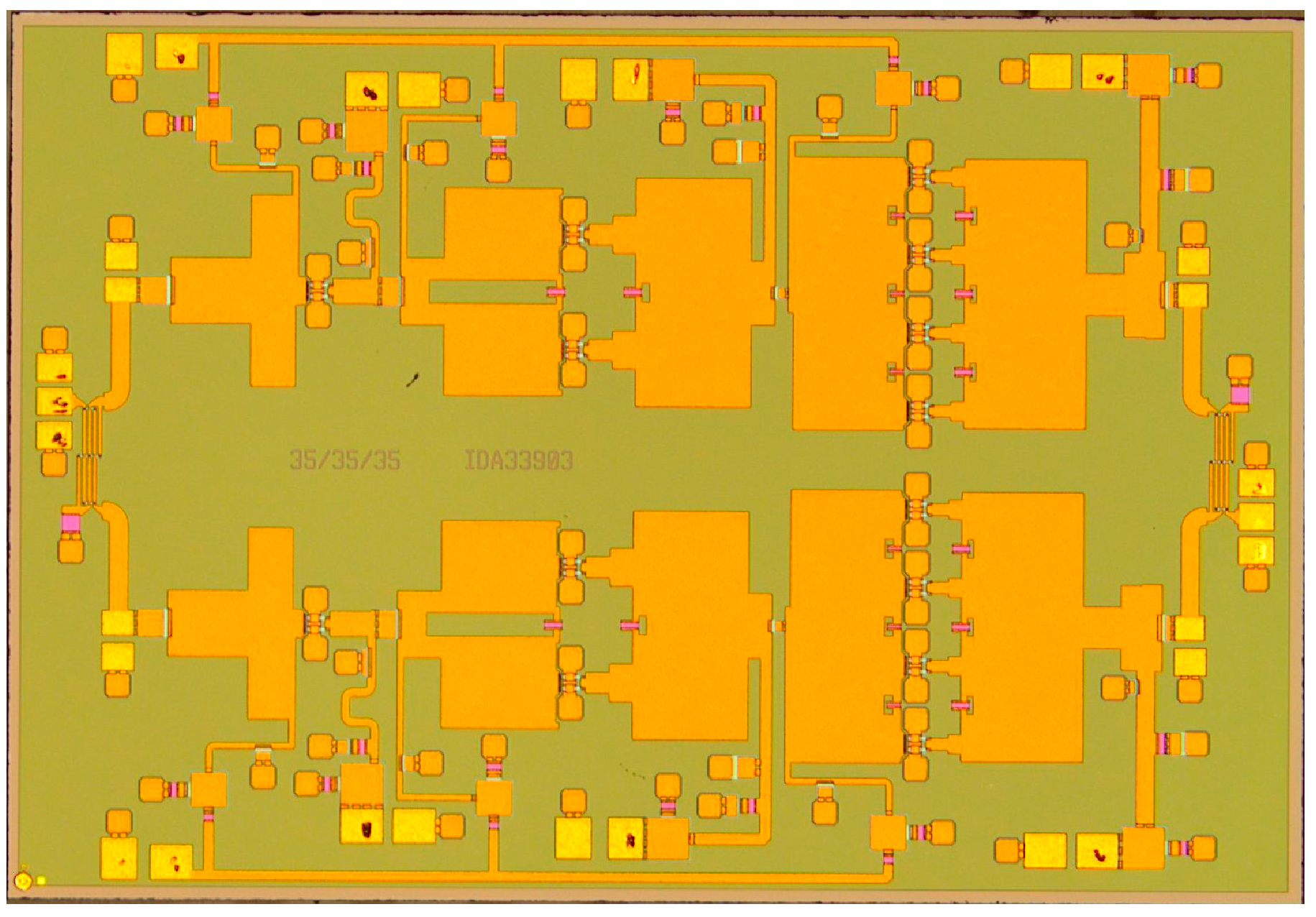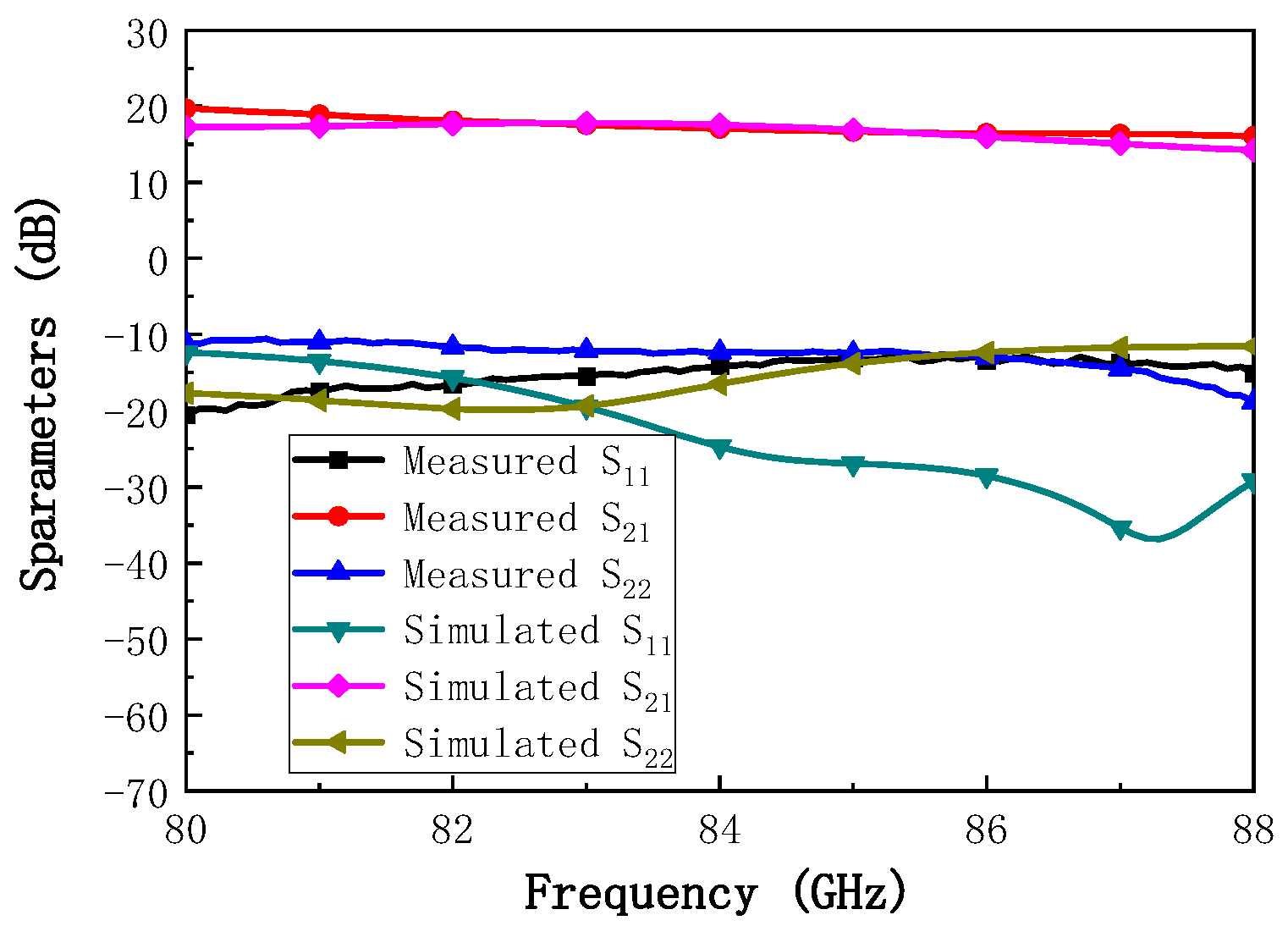Design of a High-Power, High-Efficiency GaN Power Amplifier for W-Band Applications
Abstract
1. Introduction
2. Device Technology
3. Circuit Design
3.1. Power Amplifier Design
3.2. Lange Coupler Design
4. Measurement Results
5. Conclusions
Author Contributions
Funding
Data Availability Statement
Conflicts of Interest
References
- Mishra, U.K.; Parikh, P.; Wu, Y.-F. AlGaN/GaN HEMTs—An overview of device operation and applications. Proc. IEEE 2002, 90, 1022–1031. [Google Scholar] [CrossRef]
- Kim, J. A Review of Ku-Band GaN HEMT Power Amplifiers Development. Micromachines 2024, 15, 1381. [Google Scholar] [CrossRef] [PubMed]
- Nikandish, R. GaN integrated circuit power amplifiers: Developments and prospects. IEEE J. Microw. 2023, 3, 441–452. [Google Scholar] [CrossRef]
- Camarchia, V.; Quaglia, R.; Piacibello, A.; Nguyen, D.P.; Wang, H.; Pham, A.V. A review of technologies and design tech niques of millimeter-wave power amplifiers. IEEE Trans. Microw. Theory Techn. 2020, 68, 2957–2983. [Google Scholar] [CrossRef]
- Hu, L.; Liao, X.; Zhang, F.; Wu, H.; Ma, S.; Lin, Q.; Tang, X. A Wideband High-Efficiency GaN MMIC Power Amplifier for Sub-6-GHz Applications. Micromachines 2022, 13, 793. [Google Scholar] [CrossRef] [PubMed]
- Micovic, M.; Kurdoghlian, A.; Hashimoto, P.; Hu, M.; Antcliffe, M.; Willadsen, P.J.; Wong, W.S.; Bowen, R.; Milosavljevic, I.; Schmitz, A.; et al. GaN HFET for W-band Power Applications. In Proceedings of the 2006 International Electron Devices Meeting, San Francisco, CA, USA, 11–13 December 2006; pp. 1–3. [Google Scholar]
- Micovic, M.; Kurdoghlian, A.; Shinohara, K.; Burnham, S.; Milosavljevic, I.; Hu, M.; Corrion, A.; Fung, A.; Lin, R.; Samoska, L.; et al. W-band GaN MMIC with 842 mW Output Power at 88 GHz. In Proceedings of the IEEE International Microwave Symposium (IMS), Anaheim, CA, USA, 23–28 May 2010; pp. 237–239. [Google Scholar]
- Micovic, M.; Kurdoghlian, A.; Margomenos, A.; Brown, D.F.; Shinohara, K.; Burnham, S.; Milosavljevic, I.; Bowen, R.; Williams, A.J.; Hashimoto, P.; et al. 92–96 GHz GaN Power Amplifiers. In Proceedings of the 2012 IEEE/MTT-S International Microwave Symposium Digest, Montreal, QC, Canada, 17–22 June 2012; pp. 1–4. [Google Scholar]
- Schellenberg, J.M. A 2-W W-Band GaN Traveling-Wave Amplifier with 25-GHz Bandwidth. IEEE Trans. Microw. Theory Tech. 2015, 63, 2833–2840. [Google Scholar] [CrossRef]
- Marti, D.; Lugani, L.; Carlin, J.F.; Malinverni, M.; Grandjean, N.; Bolognesi, C.R. W-Band MMIC Amplifiers Based on AlInN/GaN HEMTs Grown on Silicon. IEEE Electron Device Lett. 2016, 37, 1025–1028. [Google Scholar] [CrossRef]
- Shaobing, G.; Jianfeng, W.; Weibo, W.; Junyun, Z. W-Band MMIC PA with Ultrahigh Power Density in 100-nm AlGaN/GaN Technology. IEEE Trans. Electron Devices 2016, 63, 3882–3886. [Google Scholar] [CrossRef]
- Ture, E.; Brückner, P.; Alsharef, M.; Granzner, R.; Schwierz, F.; Quay, R.; Ambacher, O. First Demonstration of W-band Tri-gate GaN-HEMT Power Amplifier MMIC with 30 dBm Output Power. In Proceedings of the 2017 IEEE MTT-S International Microwave Symposium (IMS), Honolulu, HI, USA, 4–9 June 2017; pp. 35–37. [Google Scholar]
- Ćwikliński, M.; Friesicke, C.; Brueckner, P.; Schwantuschke, D.; Wagner, S.; Lozar, R.; Massler, H.; Quay, R.; Ambacher, O. Full W-Band GaN Power Amplifier MMICs Using a Novel Type of Broadband Radial Stub. IEEE Trans. Microw. Theory Tech. 2018, 66, 5664–5675. [Google Scholar] [CrossRef]










| References | Process | Frequency (GHz) | Saturated Output Power (dBm) | Gain (dB) | PAE/% |
|---|---|---|---|---|---|
| [6] | GaN | 75–110 | 25 | 22 | 14 (peak) |
| [7] | GaN | 84–92 | 29.3 | 19.6 | 15 (peak) |
| [8] | GaN | 92–96 | 32 | 10 | 20 (peak)/17.8 (avg.) |
| [9] | GaN | 75–100 | 34 | 14 | 12 (peak) |
| [10] | GaN | 90–100 | 18.3 | 8.2 | 7 (peak) |
| [11] | GaN | 90–97 | 32.2 | 16.7 | 21 (peak) |
| [12] | GaN | 86–94 | 30.6 | 12 | 8 (peak) |
| [13] | GaN | 70–110 | 28.6 | 13 | 8.6 (peak) |
| This work | GaN | 80–86 | 35 | 17 | 24 (peak)/22 (avg.) |
Disclaimer/Publisher’s Note: The statements, opinions and data contained in all publications are solely those of the individual author(s) and contributor(s) and not of MDPI and/or the editor(s). MDPI and/or the editor(s) disclaim responsibility for any injury to people or property resulting from any ideas, methods, instructions or products referred to in the content. |
© 2025 by the authors. Licensee MDPI, Basel, Switzerland. This article is an open access article distributed under the terms and conditions of the Creative Commons Attribution (CC BY) license (https://creativecommons.org/licenses/by/4.0/).
Share and Cite
Liu, S.; Ma, X.; Zhang, Y.; Xu, C. Design of a High-Power, High-Efficiency GaN Power Amplifier for W-Band Applications. Micromachines 2025, 16, 985. https://doi.org/10.3390/mi16090985
Liu S, Ma X, Zhang Y, Xu C. Design of a High-Power, High-Efficiency GaN Power Amplifier for W-Band Applications. Micromachines. 2025; 16(9):985. https://doi.org/10.3390/mi16090985
Chicago/Turabian StyleLiu, Shuai, Xiaohua Ma, Yi Zhang, and Chunliang Xu. 2025. "Design of a High-Power, High-Efficiency GaN Power Amplifier for W-Band Applications" Micromachines 16, no. 9: 985. https://doi.org/10.3390/mi16090985
APA StyleLiu, S., Ma, X., Zhang, Y., & Xu, C. (2025). Design of a High-Power, High-Efficiency GaN Power Amplifier for W-Band Applications. Micromachines, 16(9), 985. https://doi.org/10.3390/mi16090985





